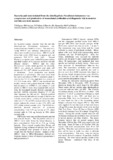Bacteria and toxin isolated from the dinoflagellate Pyrodinium bahamense var. compressum and production of monoclonal antibodies and diagnostic kits to monitor red tide and toxic mussels
- Global styles
- MLA
- Vancouver
- Elsevier - Harvard
- APA
- Help
Share
Abstract
Six bacterial isolates obtained from the red tide dinoflagellate Pyrodinium bahamense var. compressum were found to be toxic. The most toxic isolate MM-11 was cultured, characterized, and identified to be Micrococcus luteus. MM-11 and M. luteus had similar DNA bands on agarose gel, and contained 70.0–75.5% mole G+C. Several Micrococcus species were isolated from pure culture and field samples of Pyrodinium and from red tide affected mussels. MM-11 and the other Micrococcus isolates tested positive for saxitoxin. MM-11 was grown on seawater agar; peak cell density of 1.36 x 1010 cells/ml occurred after 3 days of incubation. Toxin production was directly proportional to cell density. The crude toxin from the optimized culture of MM-11 resulted in death of mice in only 1.8–2.4 min, equivalent to a toxicity of 5.9–13.4 mouse units. MM-11 was inoculated into healthy mussels and yielded bacterial isolates that had characteristics of MM-11, and extracts of toxin similar to MM-11 toxin. Mice injected with extracts from the inoculated mussels showed symptoms of paralytic shellfish poisoning (dyspnea 12–15 min after injection), but did not die. Partially purified extracts from red tide affected mussels killed mice in 3.4 min, equivalent to a toxicity of 3.4 mouse units. Addition of 5, 25 and 50% coconut milk to this toxin extract reduced the toxicity to only 34%, 29%, and 25% of that without coconut milk. The ELISA test similarly showed reduction of saxitoxin concentration from 4.78 g toxin/g at 5% added coconut milk to 3.62 g toxin/g at 50% added coconut milk.
PSP toxins were extracted from bacteria and red tide affected mussels. The 24 purified extracts of MM-11 toxin were shown by mouse bioassay to have concentrations from 0.6 to 71.6 μg toxin/g bacteria. Green mussels sampled from Bataan and Zambales during incidence of red tides from 1994 to 1998 contained lower amounts of toxin per unit weight than the bacterial extracts. Analysis of the MM-11 toxin by HPLC-fluorometry showed two fractions similar to those of standard gonyautoxin 1 and gonyautoxin 3.
Keywords
Pyrodinium bahamense var. compressumSuggested Citation
Espino, T. M., Aspiras, R. M., Sabino, N. G., Parreño, E., Macasadia, R. L., & del Mundo, M. L. F. (2007). Bacteria and toxin isolated from the dinoflagellate Pyrodinium bahamense var. compressum and production of monoclonal antibodies and diagnostic kits to monitor red tide and toxic mussels. In T. U. Bagarinao (Ed.), Research Output of the Fisheries Sector Program (Vol. 2. Reports on Fisheries and Aquaculture, pp. 187-201). Quezon City, Philippines: Bureau of Agricultural Research, Department of Agriculture.
Type
Book chapterISBN
9718511776


